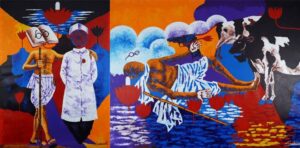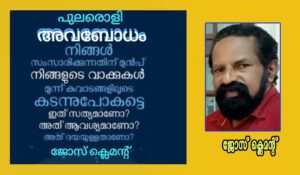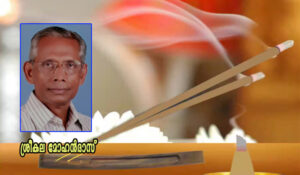 Artist Sedunath Prabhakar who is the first Indian Artist to hold the painting exhibition in the parliament of Australia sets his latest contemporary paintings and gets ready to conduct another prestigious exhibition in different countries. There is one series, but two subjects. One is ‘portraits of Indian gods’ and the other is ‘portraits of Gandhi’. Both series demolish the untouchable holy pillars of Indian mythology and history. Eventually it deciphers the hidden history of faith and polarization in this subcontinent.
Artist Sedunath Prabhakar who is the first Indian Artist to hold the painting exhibition in the parliament of Australia sets his latest contemporary paintings and gets ready to conduct another prestigious exhibition in different countries. There is one series, but two subjects. One is ‘portraits of Indian gods’ and the other is ‘portraits of Gandhi’. Both series demolish the untouchable holy pillars of Indian mythology and history. Eventually it deciphers the hidden history of faith and polarization in this subcontinent.
‘Indian gods/goddesses’ series goes through Indian mythology and finds the settlements of the Brahmanical hierarchie which migrated to south Asia and emerged after the decline of Harappan civilization. They assimilated the scattered or polyphonic images of deities and made a linear structure of gods and goddesses. Brahmanism sets the structure of hierarchy of triumvirate gods as ‘Brahma’, ‘Vishnu’ and ‘Shiva’ and puts all other deities under the three. The Brahmin hierarchy was mythology makers and they have been doing the job in modern society as well. In the part of the Brahmanism establishment they had to add the other groups’ deities into the brahmanical terms, even tribal gods/godesses. Eventually it brought lots of contradictory concepts and rituals in Brahmanic religion, like animal scarification.’

Narration of 2 painting of the series:
Sarswati
According to Brahmanical texts Saraswati emanated from Brahma ( the creator god ) who is one of the Triumvirates. She was daughter of Brahma and the consort of the creator too. Some scripts say that she was the first wife of Lord Vishnu, the preserver and protector god and he gave her to Brahma.
The patriarchal Brahmanic hierarchie made the myth of goddess Saraswati and set her to accompany the creator god. She carries Veena ( an Indian musical instrument). According to historical evidence, Veena emerged in 1000 BCE. It shows that the people added this goddess later in the Veda period, on the way of Brahmanical establishment in South Asia. Brahmanism relegates the Dravidian people as they are untouchable demons.They assimilated them in four fold ‘ Varna’ division and interpreted that all these people are the part of Brahmanic religion. In CE ( Common Era ) the term of Brahmanism turned to Hinduism.
Here Saraswati is a woman who is set by a phallocentric society to follow her consort, sits on the lotus which is a soft flower but can be penetrated in a soft image or position and holds Veena. Although figuratively she always sits on the lap of Brahmanism.
Krishna
Krisha is a god of Brahmanism which can define the glorification of counterfeits. According to the texts Krishna was born in the Yadhava clan ( A caste and old dynasty of India ). According to Brahmin authority, Yadava holds the lowest position of four fold (Varna) division as ‘Shudra’. They were cattle herders. Krishna and his friends spent their childhood and teenage years with cattles as what their tribe prescribed or practiced.
He was a monumental lover too. He holds lots of wives and loved ones, even though he could love one person deeply. It might be common in both gender bonding. Krishna was admired by the young ladies who followed him in the ancient texts and so on in modern society too. He holds and looks after those ladies as his cattles.
In the epic text Mahabharata Krisha takes a key role in Pandavas’ ( the five warriors ) life as well as in the Kurukshetra war. According to the text 3.94 million warriors participated in the Kurukshetra war. The historical proof shows that the total population of South Asia in 3000 BCE was very less than the text mentioned. 3000 BCE was a bronze age too. There was not much vestige of weapons found from the excavations in Kurukshetra as for a huge war. The probable assumption is that it was an internal conflict of a tribe or a skirmish of different tribes. Most probably the pro text was a folktale and Krishna was the local hero of one of the clans. The part of Brahmanical religious establishment and extending mythology purpose, the myth makers assimilated the image of Krisha as the 8th incarnation of Vishnu. Even though the literary interpretation of Krisha is a wonderful part of Mahabharata.
Gandhi
History is not just what happened in the olden days, but it is an index finger of what it would be. The paintings depicted Gandhi’s deal with other iconic figures at that time as well as his acceptance and rejections of them. He emphasized secularism, but stands up for the cultural hindutva as well. Gandhi believed in vedas and its four fold ‘Varna’ division and brought it up that hindutva within congress politics. He always carried a ‘Gita’. Gandhi’s cultural hindutva turned to political hindutva through V D Savarkar and Hedgewar. The funniest thing is that both Gandhi and Nathuram Godse carried a Gita as their guidance.
Gandhi’s acceptance and rejection of the other icons who are part of freedom fighting was not on the basis of their political caliber, but it was from his personal thoughts. Bhagat Singh and Ambedkar were the most popular examples of the rejection. Gandhi brought it up a national muslim and argued for them, but he denied Muhammad Ali Jinnah. He holds certain people like Nehru, Sardar Patel and denies others.
What hindutva he inserted in the Indian national Congress through freedom fighting, that stream separately emerged with a political goal and it made a gunshot to his heart. Even though Gandhi is the one and only great icon of socio- political history in the world.
You can try to wipe out this name, you can derogate this name, you can manipulate about his walks, but which name will come out to the timelessness, and the name is Mahatma Gandhi. Here Gandhi is not a holy cow; he is a man of seeking and traveling in both self and exterior. The walking man is not an iron pillar, not patinated, and making mistakes at a time are not making a man of mistakes.
About The Author
No related posts.




